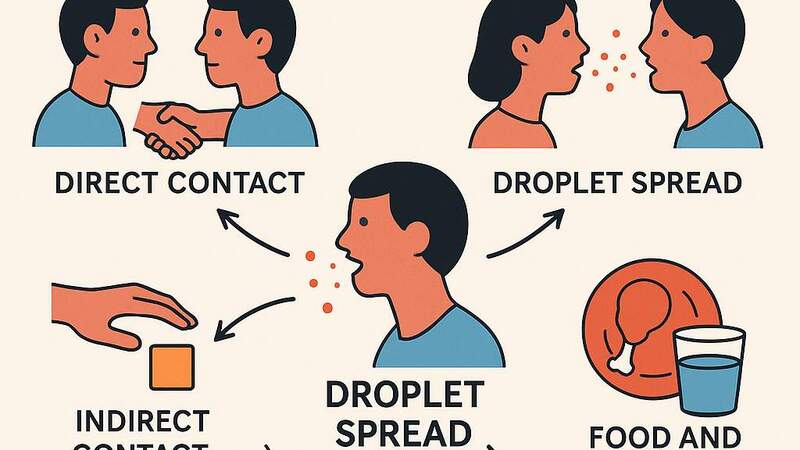In today’s digital age, unusual words and fabricated terms often appear online, sparking curiosity and confusion. One such word is zikzoutyqulsis. People sometimes search for “how zikzoutyqulsis spread,” assuming it refers to a mysterious disease. However, the truth is that zikzoutyqulsis does not exist in medical science. It is not a real disease, nor does it spread in any community. Instead, the word seems to have been invented for online attention or as part of internet jargon.
That said, exploring this idea gives us a valuable opportunity. While zikzoutyqulsis itself is fictional, questions about how diseases spread are very real and deeply important. Infectious diseases have shaped human history, influenced social behaviors, and even changed global politics. By understanding transmission routes, people can make informed decisions that protect both their own health and the well-being of their communities.
This article will provide a complete guide to how real infectious diseases spread, the myths that surround fictional ones like zikzoutyqulsis, and the lessons we can draw from science. We will also highlight the importance of prevention, global health strategies, and how digital misinformation plays a role in shaping public understanding.
Why People Search for Made-Up Diseases
Curiosity and Clickbait
The internet thrives on unusual or strange words. When people see a confusing term like zikzoutyqulsis, they become curious. Search engines and social media platforms often reward curiosity with visibility. As a result, made-up words spread quickly, not because they represent reality, but because they catch attention.
Fear and Health Concerns
Public health is one of the most sensitive topics worldwide. When people hear about a new or unknown condition, they instinctively worry about safety. Even though zikzoutyqulsis is fictional, some users might assume it is real and look for information, similar to how rumors spread during outbreaks.
Lessons from Misinformation
The rise of fabricated terms teaches us the importance of verifying health information. Trustworthy sources such as the Centers for Disease Control and Prevention (CDC), the World Health Organization (WHO), and peer-reviewed journals provide accurate guidance. Without fact-checking, individuals may panic unnecessarily or adopt harmful practices.
How Real Diseases Spread: The Scientific Truth
Even though zikzoutyqulsis is not real, real infectious diseases have well-documented transmission routes. Understanding them helps prevent epidemics and empowers communities.
1. Direct Contact Transmission
-
Definition: Transmission through physical touch with an infected person or animal.
-
Examples: Shaking hands, hugging, or contact with open wounds.
-
Diseases Spread This Way: Herpes, HIV (through bodily fluids), and skin infections such as ringworm.
Direct contact is one of the oldest and simplest forms of transmission. Families, schools, and workplaces often see outbreaks due to close interaction. Preventive strategies include frequent handwashing, avoiding direct exposure to wounds, and practicing safe hygiene.
2. Droplet Transmission
-
Definition: Occurs when infected people cough, sneeze, or even talk, releasing droplets.
-
Examples: Influenza, COVID-19, and whooping cough.
Droplets usually fall quickly within a short distance (1–2 meters). That is why health experts recommend wearing masks, covering sneezes, and maintaining physical distance during outbreaks.
3. Airborne Transmission
-
Definition: Certain pathogens remain suspended in the air for long periods.
-
Examples: Tuberculosis, measles, chickenpox, and COVID-19 in poorly ventilated areas.
Airborne transmission is particularly dangerous because you can get infected without direct contact. Proper ventilation, HEPA filters, and N95 masks are effective defenses.
4. Indirect Contact (Fomite Transmission)
-
Definition: Pathogens survive on objects or surfaces (fomites).
-
Examples: Doorknobs, keyboards, elevator buttons.
Respiratory viruses like RSV or cold viruses often spread this way. Cleaning high-touch surfaces and practicing personal hygiene are key prevention methods.
5. Vector-Borne Transmission
-
Definition: Insects or animals carry pathogens and spread them to humans.
-
Examples: Mosquitoes transmit malaria, Zika, and dengue. Ticks spread Lyme disease.
Vector control measures, including insect repellents, bed nets, and habitat management, have saved millions of lives worldwide.
6. Food and Waterborne Transmission
-
Definition: Consumption of contaminated food or water.
-
Examples: Cholera, E. coli infections, and hepatitis A.
This route highlights the importance of clean drinking water, food safety regulations, and global sanitation efforts.
The Role of Modern Society in Disease Spread
Global Travel and Trade
Airplanes and ships can carry pathogens worldwide in hours. An outbreak in one country can quickly become a global pandemic. COVID-19 is the most recent example of how interconnected societies amplify transmission.
Urbanization and Crowding
Cities with dense populations create environments where diseases spread rapidly. Public transport, crowded housing, and poor sanitation can intensify risks.
Climate Change and Environment
Rising temperatures expand mosquito habitats, increasing the risk of vector-borne diseases in regions that never faced them before.
Digital Myths: Zikzoutyqulsis as a Case Study
Although zikzoutyqulsis is a fabricated term, it demonstrates how quickly misinformation spreads. Online discussions about nonexistent illnesses often mirror real outbreaks in tone, urgency, and public concern. This has three consequences:
-
Wasted Attention: Instead of learning about genuine risks, people chase fake news.
-
Panic Without Basis: Imaginary threats cause unnecessary anxiety.
-
Education Opportunity: Misinformation can be redirected into learning moments about real diseases.
By reframing the conversation, we can turn questions like “how zikzoutyqulsis spread” into opportunities to explain scientific truths about disease transmission.
Prevention: What Really Works
Personal Habits
-
Wash hands regularly with soap.
-
Wear masks when recommended.
-
Cover mouth and nose when sneezing or coughing.
-
Avoid touching face with unwashed hands.
Environmental Strategies
-
Improve ventilation in homes and offices.
-
Sanitize high-touch surfaces frequently.
-
Ensure access to safe drinking water.
Community and Global Efforts
-
Vaccination programs build herd immunity.
-
Public awareness campaigns reduce myths.
-
International cooperation strengthens response to pandemics.
Case Studies: Real Outbreaks and Lessons Learned
1. The Spanish Flu (1918–1919)
Killed millions worldwide. Spread through soldiers, cities, and poor sanitation. Taught the world the importance of public health measures.
2. HIV/AIDS (1980s – present)
Spread mainly through direct contact with bodily fluids. Showed the need for awareness campaigns and safe practices.
3. COVID-19 (2019 – present)
Highlighted droplet, airborne, and surface transmission. Reinforced the importance of global cooperation, vaccine development, and digital communication.
The Impact of Technology and Social Media
The internet has transformed how people perceive diseases. Platforms spread both facts and myths instantly. Words like zikzoutyqulsis gain traction not because of medical relevance, but because of digital curiosity. This emphasizes two needs:
-
Critical Thinking: Users must evaluate sources before believing or sharing.
-
Health Literacy: Schools and communities must teach people to identify trusted information.
Conclusion
The keyword “how zikzoutyqulsis spread” may sound like it describes a dangerous outbreak, but the truth is simple: zikzoutyqulsis is not real, it does not spread, and it has no medical basis. However, curiosity about this phrase opens an important discussion about how genuine diseases do spread and what society can do to stop them.
By learning about direct contact, droplets, airborne particles, fomites, vectors, and contaminated food or water, we gain the knowledge to protect ourselves. At the same time, by understanding digital myths, we prepare to face misinformation wisely.
Health is not just about fighting infections—it is about fostering awareness, practicing prevention, and building resilience. Even though zikzoutyqulsis is fictional, the lessons drawn from this discussion are very real and essential for everyone.
For more info visit Stylishfame

